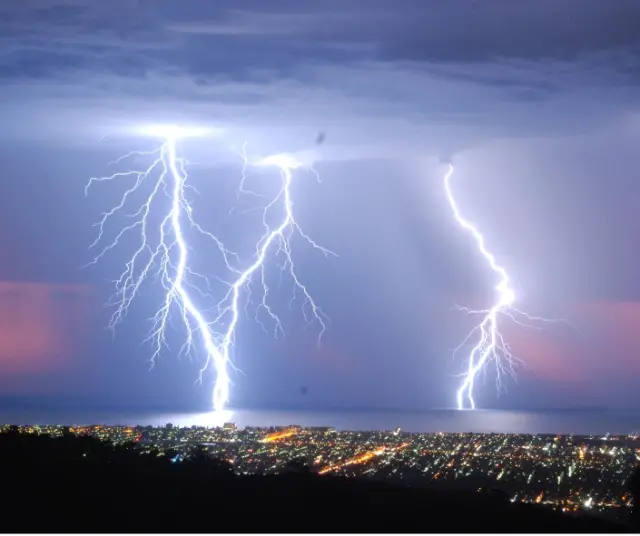Thunderstorms, those natural phenomena that inspire equal parts awe and fear, are impressive spectacles of the force of nature. With their lightning lighting up the sky, rumbling thunder, and the potential for devastating damage, thunderstorms are a powerful reminder of the intrinsic power of the atmosphere and its ability to unleash its fury anytime, anywhere.
What is a Thunderstorm?
A thunderstorm is a meteorological phenomenon characterized by the presence of lightning and thunder, caused by electrical discharges in the atmosphere. These discharges can occur both within a cloud (intracellular) and between different clouds (intercellular), and can even reach the earth in the form of lightning. Thunderstorms typically form in unstable atmospheric conditions, where there is a combination of humidity, heat, and vertical air movement.
Formation of Thunderstorms
The formation of a thunderstorm is a complex process that involves several interrelated atmospheric factors. It all starts with the presence of warm, humid air near the Earth's surface. This air rises due to updrafts, creating vertically developing clouds known as cumulonimbus clouds. Within these clouds, water and ice particles collide with each other, generating electrical charges. As these charges separate, an electric field is created, giving rise to lightning and thunder.
Types of Thunderstorms
There are several types of thunderstorms, each with its distinctive characteristics:
Isolated Storms: These are individual storms that form in specific areas and may be relatively small in size.
Storm Lines: They form along frontal or convergence lines, creating a succession of storms that can extend for hundreds of kilometers.
Supercells: They are highly organized and persistent storms, characterized by their internal rotation and the presence of strong updrafts. Supercells are known to be the most dangerous, as they can generate tornadoes and large hail.
Environmental impact
Thunderstorms can have a significant impact on the environment, both in the short and long term. On the one hand, they can trigger forest fires due to lightning striking dry areas with flammable vegetation. On the other hand, electrical discharges in the atmosphere contribute to the production of ozone, a crucial component of the stratosphere that protects the Earth from harmful ultraviolet radiation.
Social and Economic Impact
In addition to their environmental impact, thunderstorms can have significant social and economic consequences. Lightning can cause damage to electrical and telecommunications infrastructure, leaving entire communities without power or cut off from communication. Additionally, heavy rainfall associated with storms can cause flooding, damaging homes, roads and crops, and causing considerable economic losses.
Security measures
Faced with the threat of a thunderstorm, it is essential to follow certain safety measures to protect yourself and others:
Seek Shelter: Seek safe shelter in a building or vehicle with a metal roof.
Avoid High and Open Places: Stay away from elevated areas, tall trees, metal poles and bodies of water.
Do not take shelter under isolated trees: Trees can act as natural lightning rods and attract lightning, making it dangerous to take shelter under them during a storm.
Technological Advances in the Prediction and Prevention of Thunderstorms
In recent decades, technological advances in thunderstorm prediction and prevention have revolutionized our ability to anticipate and mitigate the impacts of these extreme weather events. One of the most significant developments has been the implementation of Doppler weather radars, which allow meteorologists to accurately monitor the movement and intensity of storms in real time. These radars can detect changes in wind speed and direction within clouds, providing vital information about possible lightning formation and the likelihood of a storm becoming severe.
Weather satellites play a crucial role in observing and tracking thunderstorms on a regional and global scale. These satellites use a variety of instruments to measure key atmospheric parameters, such as temperature, humidity, and the concentration of charged particles, allowing scientists to more accurately predict the evolution of storms and issue early warnings to at-risk communities. .
Another important advance has been the development of numerical weather prediction models, which use complex algorithms and real-time meteorological data to simulate the behavior of the atmosphere and predict the path of storms days in advance. These models can identify atmospheric patterns favorable for the formation of thunderstorms and calculate the probability of them occurring in specific areas, allowing authorities to take preventative measures and evacuate people in danger.
In addition to prediction, technology has also improved our abilities to prevent the impacts of thunderstorms. Early warning systems, which use a combination of radar, satellites and prediction models, can issue automatic alerts through text messages, mobile apps and emergency sirens, informing the population of the approach of a storm and providing instructions. about what to do to stay safe.
